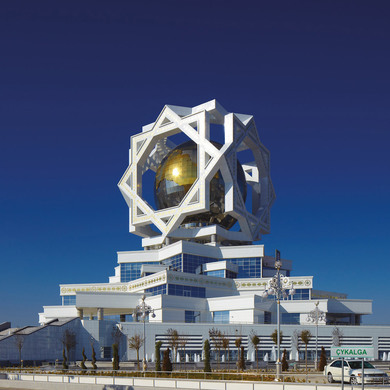Wedding Palace, Turkmenistan
The Wedding Palace is a civil registry wedding venue in Ashgabat, Turkmenistan. It was commissioned by the national government and built by Turkish firm Polimeks, who completed it in 2011.
The 11 storey building covers an area of over 38,000 sq. m (410,000 sq. ft). It comprises three tiers, each side of which is shaped like an 8-pointed star. These tiers are staggered so that their points do not overlap.
On top of the building a massive 32m diameter ‘mirrorball’ globe features gold titanium maps of Turkmenistan. This is enclosed by a frame of 8-sided Turkmen stars.
The palace interior was designed in the traditional Turkmen style, and contains six rooms for marriage registration, holding up to 1,000 people. In the central part of the globe, the Golden Hall is also used for weddings.
The palace also contains a hotel, shopping centre, bridal rooms, cafes and an underground car park, while the exterior is surrounded by a landscape incorporating waterfall fountains and decorative plants.
[edit] Related articles on Designing Buildings Wiki
Featured articles and news
Homes England supports Greencore Homes
42 new build affordable sustainable homes in Oxfordshire.
Zero carbon social housing: unlocking brownfield potential
Seven ZEDpod strategies for brownfield housing success.
CIOB report; a blueprint for SDGs and the built environment
Pairing the Sustainable Development Goals with projects.
Types, tests, standards and fires relating to external cladding
Brief descriptions with an extensive list of fires for review.
Latest Build UK Building Safety Regime explainer published
Key elements in one short, now updated document.
UKGBC launch the UK Climate Resilience Roadmap
First guidance of its kind on direct climate impacts for the built environment and how it can adapt.
CLC Health, Safety and Wellbeing Strategy 2025
Launched by the Minister for Industry to look at fatalities on site, improving mental health and other issues.
One of the most impressive Victorian architects. Book review.
Common Assessment Standard now with building safety
New CAS update now includes mandatory building safety questions.
RTPI leader to become new CIOB Chief Executive Officer
Dr Victoria Hills MRTPI, FICE to take over after Caroline Gumble’s departure.
Social and affordable housing, a long term plan for delivery
The “Delivering a Decade of Renewal for Social and Affordable Housing” strategy sets out future path.
A change to adoptive architecture
Effects of global weather warming on architectural detailing, material choice and human interaction.
The proposed publicly owned and backed subsidiary of Homes England, to facilitate new homes.
How big is the problem and what can we do to mitigate the effects?
Overheating guidance and tools for building designers
A number of cool guides to help with the heat.
The UK's Modern Industrial Strategy: A 10 year plan
Previous consultation criticism, current key elements and general support with some persisting reservations.
Building Safety Regulator reforms
New roles, new staff and a new fast track service pave the way for a single construction regulator.
























